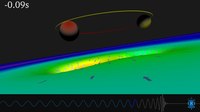
Photo from wikipedia
With the popularity of smart phones, non-contact video-based vital sign monitoring using a camera has gained increased attention over recent years. Especially, imaging photoplethysmography (IPPG), a technique for extracting pulse… Click to show full abstract
With the popularity of smart phones, non-contact video-based vital sign monitoring using a camera has gained increased attention over recent years. Especially, imaging photoplethysmography (IPPG), a technique for extracting pulse waves from videos, conduces to monitor physiological information on a daily basis, including heart rate, respiration rate, blood oxygen saturation, and so on. The main challenge for accurate pulse wave extraction from facial videos is that the facial color intensity change due to cardiovascular activities is subtle and is often badly disturbed by noise, such as illumination variation, facial expression changes, and head movements. Even a tiny interference could bring a big obstacle for pulse wave extraction and reduce the accuracy of the calculated vital signs. In recent years, many novel approaches have been proposed to eliminate noise such as filter banks, adaptive filters, Distance-PPG, and machine learning, but these methods mainly focus on heart rate detection and neglect the retention of useful details of pulse wave. For example, the pulse wave extracted by the filter bank method has no dicrotic wave and approaching sine wave, but dicrotic waves are essential for calculating vital signs like blood viscosity and blood pressure. Therefore, a new framework is proposed to achieve accurate pulse wave extraction that contains mainly two steps: 1) preprocessing procedure to remove baseline offset and high frequency random noise; and 2) a self-adaptive singular spectrum analysis algorithm to obtain cyclical components and remove aperiodic irregular noise. Experimental results show that the proposed method can extract detail-preserved pulse waves from facial videos under realistic situations and outperforms state-of-the-art methods in terms of detail-preserving and real time heart rate estimation. Furthermore, the pulse wave extracted by our approach enabled the non-contact estimation of atrial fibrillation, heart rate variability, blood pressure, as well as other physiological indices that require standard pulse wave.
Journal Title: Biomedical optics express
Year Published: 2020
Link to full text (if available)
Share on Social Media: Sign Up to like & get
recommendations!